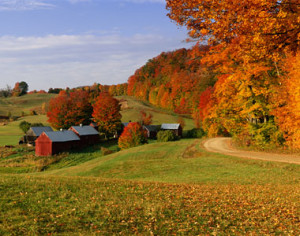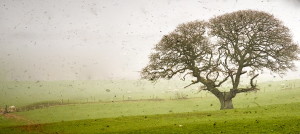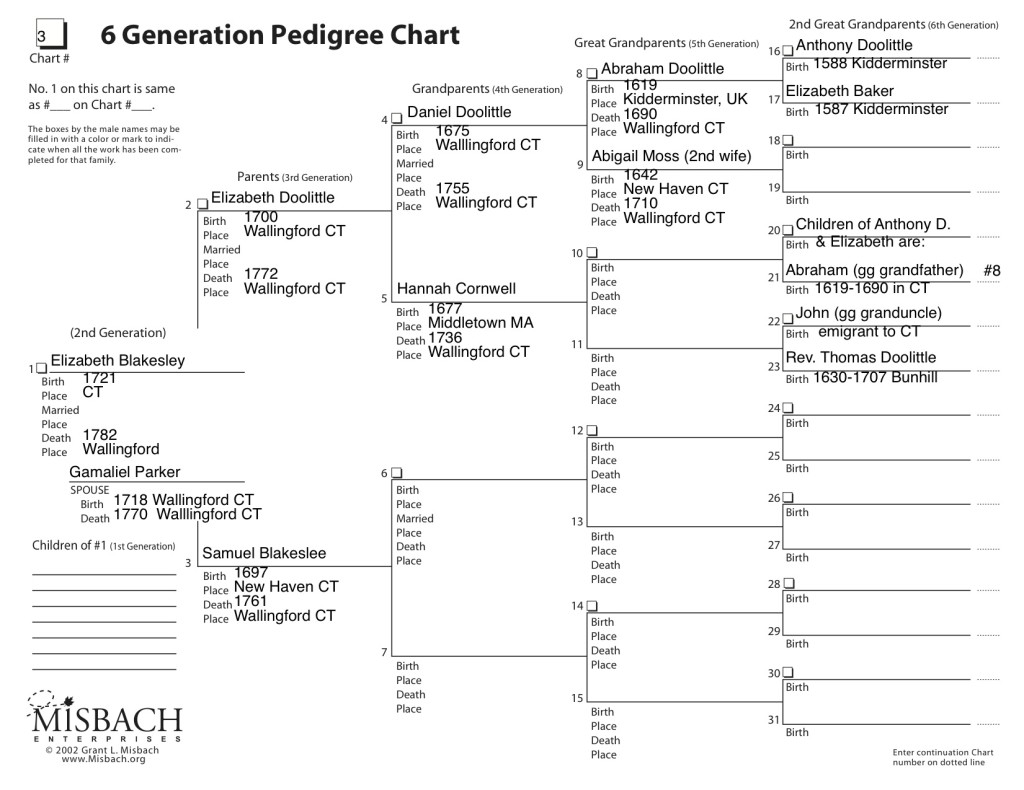The Josephine Parker Branch
The Blakeslee and Doolittle families were well established New Englanders gaining a foothold on this continent in the 1600s. Samuel Blakeslee was born 1624 in Essex, England. Abraham Doolittle was born 1619 in Kiddermaster, Worcestershire, England. Doolittle, Blakeslee and their wives are found in the tree of Great Grandmother Josephine Parker. Samuel Blakeslee married Hannah Potter who was born in 1639 in New Haven, Connecticut. Her parents, John and Elizabeth Rose Wood Potter were early settlers in New Haven. Elizabeth Rose Wood was born in Amersham, England, a village that has appeared a few times in my research.
Abraham Doolittle married Abigail Moss, the daughter of Captain John Moss and Abigail Charles. The Captain was born in Wiltshire, England somewhere in the neighborhood of Peeter Smith. Small world. Abigail I don’t know. She was born, that much I am sure of. All these details mean very little to me. But the story of their lives is actually pretty fascinating. Perhaps that is why I picked them out of the litter available. I will begin with New Haven, Connecticut because it ties into another branch of the Whittington family tree and your ancestors had a whole lot to do with the establishment of New Haven as one of the first American communities.
Thomas Doolittle
Thomas is a great uncle from 350 years ago! Thomas was held in high esteem by rebellious souls who dreamed of a God that didn’t meet the specifications of the either the Pope or the British monarch. Doolittle’s brothers (John and Abraham) came to the New World and populated it profusely. The Doolittles eventually marry into the Parker family in Connecticut who are also producing offspring at an alarming rate, over the course of several generations before Josephine Parker married Great Grandfather, Bruce Slaymaker. The Parker Family Tree is attahed here, so you can get a sense for how it leads to the present moment.
I was hoping to find an online map of Bunhill itself that might lend itself to locating specific headstones. No such luck just yet. I will keep searching online. I was hoping the Brits would made this easy to locate a stone at Bunhill. If not please do not fret about it as I understand 125,000 folks are buried there. And, if I am not mistaken the Brits find it easier to mow the grass in a cemetary if they simply move the ancient stones to one side of a field against the old stone walls. I recall that from my trip to Canterbury. Thomas Doolittle should be buried among the 300 non conformist preachers if they have them all centrally located, which may put him in the vicinity of John Bunyan and Daniel Defoe …unless they have those two buried among the authors instead….
Thomas is typical of many of your great grandparents who fled England during the Great Migration in the wake of the damage inflicted by Archbishop William Laud and King Charles I in the 1630’s. I have been trying to pull together their bios into a manuscript… but there is so much info out there that I am at times overwhelmed…. so I am going to paste together links and blurbs…. for our descendants to have access to…. But, I have often wondered what happened to those aunts and uncles who remained in England and Thomas Doolittle is a great character and story…..
Thomas Doolittle bio
From Wikipedia, the free encyclopedia
Thomas Doolittle (1632?–1707) was an English nonconformist minister, tutor and author.
Early life
Doolittle was the third son of Anthony Doolittle, a glover, and was born at Kidderminster in 1632 or the latter half of 1631. While at the grammar school of his native town he heard Richard Baxter preach as lecturer (appointed 5 April 1641) the sermons later published as ‘The Saint’s Everlasting Rest’ (1653). These discourses produced a conversion. Placed with a country attorney, he objected to copying writings on Sunday, and went home determined not to follow the law. Baxter encouraged him to enter the ministry.
He was admitted as a sizar at Pembroke Hall, Cambridge, on 7 June 1649, then aged 17. His tutor was William Moses, later ejected from the mastership of Pembroke. Doolittle graduated M.A. at Cambridge. Leaving the university for London he became popular as a preacher, and in preference to other candidates was chosen (1653) as their pastor by the parishioners of St. Alphage, London Wall. The living is described as sequestered in William Rastrick’s list as quoted by Samuel Palmer, but James Halsey, D.D., the deprived rector, had been dead twelve or thirteen years. Doolittle received presbyterian ordination.
On the passing of the Uniformity Act 1662 he thought it his duty to be a nonconformist, though he was poor. He moved to Moorfields and opened a boarding-school, which succeeded. He took a larger house in Bunhill Fields, where he was assisted by Thomas Vincent, ejected from St. Mary Magdalene, Milk Street.
Ejected minister
In the plague year of 1665 Doolittle and his pupils moved to Woodford Bridge, near Chigwell, close to Epping Forest, Vincent remaining behind. Returning to London in 1666, Doolittle was one of the nonconformist ministers who, in defiance of the law, erected preaching-places when churches were lying in ruins after the Great Fire. His first meeting-house (probably a wooden structure) was in Bunhill Fields, and here he was undisturbed. But when he transferred his congregation to a large and substantial building which he had erected in Mugwell (now Monkwell) Street, the authorities set the law in motion against him.
The Lord Mayor tried to persuade him to desist from preaching; he declined. On the following Saturday about midnight his door was broken open by a force sent to arrest him. He escaped over a wall, and intended to preach next day. From this he was dissuaded by his friends, one of whom (Thomas Sare, ejected from Rudford, Gloucestershire) took his place in the pulpit. The sermon was interrupted by the appearance of a body of troops. As the preacher stood his ground the officer told his men to fire.’ ‘Shoot, if you please,’ was the reply. There was uproar, but no arrests were made. The meeting-house, however, was taken possession of in the name of the king, and for some time was used as a Lord Mayor’s chapel.
On the indulgence of 15 March 1672 Doolittle took out a license for his meeting-house. Doolittle owned the premises, but he now resided in Islington, where his school had developed into an academy for ‘university learning.’ When Charles II (8 March 1673) broke the seal of his declaration of indulgence, thus invalidating the licenses granted under it, Doolittle conducted his academy with great caution at Wimbledon. At Wimbledon he had a narrow escape from arrest. He returned to Islington before 1680, but in 1683 was again dislodged. He moved to Battersea (where his goods were seized), and then to Clapham. These migrations destroyed his academy, where his pupils had included Matthew Henry, Samuel Bury, Thomas Emlyn, and Edmund Calamy. Two of his students, John Kerr, M.D., and Thomas Rowe, achieved distinction as nonconformist tutors. The academy was at an end in 1687, when Doolittle lived at St. John’s Court, Clerkenwell, and had Calamy a second time under his care for some months as a boarder. Until the death of his wife he still continued to receive students for the ministry, but apparently not more than one at a time. His last pupil was Nathaniel Humphreys.
After 1689
The Toleration Act of 1689 left Doolittle free to resume his services at Mugwell Street, preaching twice every Sunday and lecturing on Wednesdays. Thomas Vincent, his assistant, had died in 1678; later he had as assistants his pupil, John Mottershead (moved to Ratcliff Cross), his son, Samuel Doolittle (moved to Reading), and Daniel Wilcox, who succeeded him.
His Body of Divinity was an expansion of the Westminster Assembly’s shorter catechism. His private covenant of personal religion (18 November 1693) occupies six closely printed folio pages. He had long suffered from the stone and other infirmities, but his last illness was brief. He preached and catechised on Sunday, 18 May, took to his bed in the latter part of the week, lay for two days unconscious, and died on 24 May 1707. He was the last survivor of the London ejected clergy.
Family
Doolittle married in 1653, shortly after his ordination; his wife died in 1692. Of his family of three sons and six daughters all, except a daughter, were dead in 1723.
I have found additional passages online which I find touching regarding a man who certainly lived his belief system:
Bunhill Memorials: Sacred reminiscences of three hundred ministers





